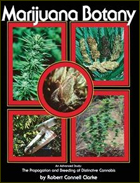
by Robert Connell Clarke
The Life Cycle and Sinsemilla Cultivation
A wild Cannabis plant grows from seed to a seedling, to a prefloral juvenile, to either pollen- or seed-bearing adult, following the usual pattern of development and sexual reproduction. Fiber and bud production both interfere with the natural cycle and block the pathways of inheritance. Fiber crops are usually harvested in the juvenile or prefloral stage, before viable seed is produced, while sinsemilla or seedless marijuana cultivation eliminates pollination and subsequent seed production. In the case of cultivated Cannabis crops, special techniques must be used to produce viable seed for the following year without jeopardizing the quality of the final product. Modern fiber or hemp farmers use commercially produced high fiber content strains of even maturation.
Monoecious strains are often used because they mature more evenly than dioecious strains. The hemp breeder sets up test plots where phenotypes can be recorded and controlled crosses can be made. A farmer may leave a portion of his crop to develop mature seeds which he collects for the following year. If a hybrid variety is grown, the offspring will not ail resemble the parent crop and desirable characteristics may be lost. Growers of seeded marijuana for smoking or hashish production collect vast quantities of seeds that fall from the flowers during harvesting, drying, and processing. A mature pistillate plant can produce tens of thousands of seeds if freely pollinated. Sinsemilla marijuana is grown by removing all the staminate plants from a patch, eliminating every pollen source, and allowing the pistillate plants to produce massive clusters of unfertilized flowers. Various theories have arisen to explain the unusually potent psychoactive properties of unfertilized Cannabis. In general these theories have as their central theme the extraordinarily long, frustrated struggle of the pistillate plant to reproduce, and many theories are both twisted and romantic. What actually happens when a pistillate plant remains unfertilized for its entire life and how this ultimately affects the cannabinoid (class of molecules found only in Cannabis) and terpene (a class of aromatic organic compounds) levels remains a mystery.
It is assumed, however, that seeding cuts the life of the plant short and THC (tetrahydrocannabinol the major psychoactive compound in Cannabis) does not have enough time to accumulate. Hormonal changes associated with seeding definitely affect all metabolic processes within the plant including cannabinoid biosynthesis. The exact nature of these changes is unknown but probably involves imbalance in the enzymatic systems controlling cannabinoid production. Upon fertilization the plant’s energies are channeled into seed production instead of increased resin production. Sinsemilla plants continue to produce new floral clusters until late fail, while seeded plants cease floral production. It is also suspected that capitate-stalked trichome production might cease when the calyx is fertilized. If this is the case, then sinsemilla may be higher in THC because of uninterrupted floral growth, trichome formation and cannabinoid production. What is important with respect to propagation is that once again the farmer has interfered with the life cycle and no naturally fertilized seeds have been produced. The careful propagator, however, can produce as many seeds of pure types as needed for future research without risk of pollinating the precious crop.
Staminate parents exhibiting favorable characteristics are reproductively isolated while pollen is carefully collected and applied to only selected flowers of the pistillate parents. Many cultivators overlook the staminate plant, considering it useless if not detrimental. But the staminate plant contributes half of the genotype expressed in the offspring. Not only are staminate plants preserved for breeding, but they must be allowed to mature, uninhibited, until their phenotypes can be determined and the most favorable individuals selected. Pollen may also be stored for short periods of time for later breeding.

